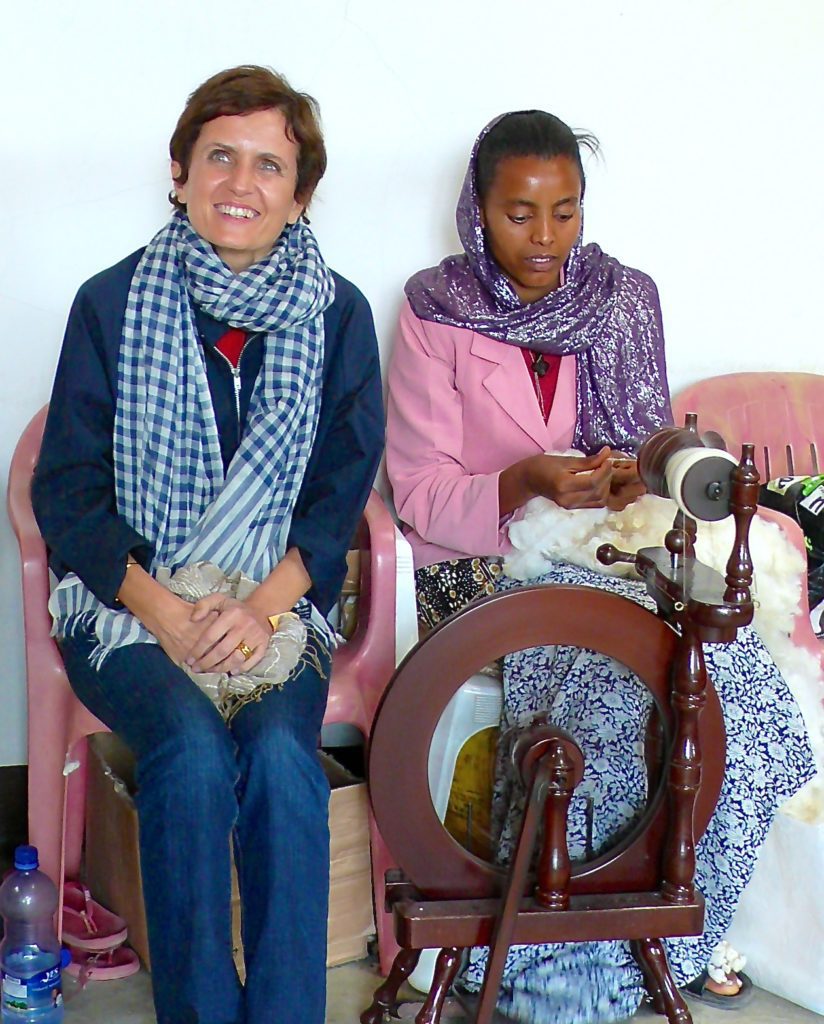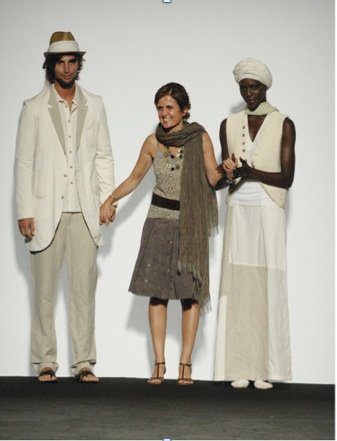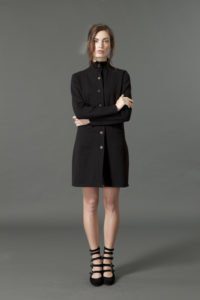I am not superstitious nor particularly obsessed with certain rituals but since the opening of this blog the number 23 has featured important releases; although I had already written a few pieces before November 23, eco-à-porter made its debut on that date, while the ‘Monthly interview’ went online on January 23 with Sass Brown, so that every subsequent interview, I felt obliged to do it go online on the 23rd of each month, cost what it may. Today is April 23 and not only is the fourth interview of the year but it is also the first day of the Fashion Revolution week, a movement that, five years after the tragedy of Rana Plaza, continues to raise awareness on the virtuous practices to be implemented involving consumers and fashion industry insiders. In short, with hindsight this 23 proved to be a significant number!
So, if today is the first day of ‘revolution’ I can not but have as a guest a revolutionary, one that terms like ‘ethics’, ‘sustainability’, ‘solidarity’ has been knowing them well before they were on everyone’s lips: Marina Spadafora is one who knows the fashion world well, daughter of textile entrepreneurs, first costume-designer and then designer but above all a spokeswoman for a change in which she firmly believes since she realized that the industry in which she operated, as it was, it was too constricting. What she found out, what experiences and what lessons, received and given, she tells us in this interview.
So Marina, coincidence wants this interview to go online on the first day of the week dedicated to the Fashion Revolution, so let’s start from here, let’s start from this movement that has become global: you are the coordinator of the Fashion Revolution Day in Italy, how did you become it and what made you do it? And what initiatives / events have you planned for this week?
I became Italian coordinator of Fashion Revolution in 2015 ‘assuming the mantle’ from Altromercato, who had played the same role for the first year, in 2014. At that time I was creative director of Auteurs du Monde, Altromercato clothing line and it was a natural passage that I accepted with enthusiasm. The reasons that motivated me are those that motivate my commitment to sustainable fashion: I am convinced that each of us can put their skills at the service of the community to help improve the world in which we live.

In the Fashion Revolution week there are many important initiatives: today there is a symposium on ethical fashion at the Bocconi University, while the weekendjust ended the Fashion Revolution Fair was held in Prato, a two days halfway between showroom and fair. On April 26th in Rome, Tiziano Guardini, eco-designer winner of the ‘Franca Sozzani GCF Award for Best Emerging Designer’ at the last edition of the ‘Green Carpet Fashion Award’, will open the doors of his own studio. April 30th will be the turn of Turin with an event full of theatrical performances, music and artistic performances and on May 8th in Milan at the Superstudio in Via Tortona will be held the annual event in collaboration with the Pistoletto Foundation to talk about sustainable fashion.
It seems like a rich program! Coming back to you, from the beginning of your career in the fashion world, it can be said that you did a bit of everything, from the costume-designer to the designer Nancy Heller’s assistant and then you became a designer yourself, with knitwear collections and then with prêt-à-porter, also extended to menswear. When did you start to ‘go to the other side’, that is, to move away from mainstream fashion to devote yourself to eco-fashion and sustainable activism? Since we are talking about ‘fashion revolution’, what was your personal revolution, what the cause behind change in your career?


It was like a crescendo from the desire to use my professionalism and put it at the service of the common good. I had my first opportunity in 2007 with the creation of the BANUQ project, a collection created entirely in Africa with organic fabrics. After that I was called first by Cangiari, the ethical fashion brand born in Calabria as an opportunity to relaunch the work on hand-looms and give opportunities to people to work outside the mafia logic. Finally, Altromercato entrusted me with the creative direction of the Auteurs du Monde clothing and accessories line, created by artisans belonging to the World Fair Trade Organization circuit.
Marina, you are my first Italian guest since I opened this column, so I’m dying to know what do you think, you, who has been working in the fashion system and in the ‘made in Italy’, about the relationship between Italian fashion and sustainability. Where are we, compared to other countries, what are the possible obstacles and what are the positive aspects to make sure that eco-fashion is no longer a niche phenomenon?
Italy is moving well in this area especially in the sector of fabric and yarn producers. Many have joined the Detox Protocol of Greenpeace and it is very encouraging to see this commitment on the part of our textile industry. The ‘famous’ brands are moving in this direction: Versace has started a path supported by the Nativa company to adopt design strategies and building systems that significantly reduce the impact on the environment, Gucci no longer uses furs, I think that with the spread of this new consumer awareness there will soon be an epochal change as when the no smoking in public places law passed, from morning till night we became virtuous and we did it much faster than many other countries. And then there are also many companies in the world of innovation such as Orange Fiber and Vegea and they are all Italian start-ups.
Auteurs du Monde is the fashion brand that you directed for Altromercato; would you like to tell me about the themes that inspired you, in addition to the materials used and the manifacture?
Auteurs du Monde is an example of ethics that meets aesthetics. Inspiration always comes from sensations I take in the world, travels, distant peoples, nature, so the clothes made are a bit like stories to wear; the high quality fabrics are made exclusively with natural and green-oriented fibers and the manufacture is strictly hand-crafted, respecting people and the environment. The collections are created by hundreds of skilled artisans, often women, who live in Asian villages, Latin America and Africa.
A question that inspired this blog: will we ever talk about eco-à-porter? Or can we already talk about it?
I sincerely hope that soon the whole fashion world will become more ethical and be the norm and not the exception. I am confident that it will soon happen.
Well Marina, our interview has come to an end but I will not let you go until you ‘nominate’ the guest of the next ‘Monthly interview’, this column works like this! Who will be and why?
Matteo Ward, founder of the brand Wrad, who found an ancient method of dyeing the materials with graphite saving on water.
Nice idea, thanks Marina, also because Matteo will be my first male guest in this wonderful sustainable universe made up of women🙂
See you in May, the 23th obviously!


















